Abstract
1. A method is described for perfusing an isolated preparation of the rabbit aortic arch with independently controlled mean pressure, pulse pressure and pulse frequency.
2. Recordings made from single or few-fibre preparations from the aortic arch and right subclavian baroreceptor regions show that the number of impulses per second or per cycle in a single fibre is the same during pulsatile perfusion as during non-pulsatile perfusion if the pressure is above the threshold pressure to non-pulsatile perfusion during all phases of the pressure cycle.
3. In multi-fibre recordings the total number of impulses is greater during pulsatile perfusion than during non-pulsatile perfusion due largely to recruitment of fibres during systole.
4. The relationship between instantaneous impulse frequency and aortic arch pressure during one pressure cycle forms an elliptiform curve.
5. Increasing the pulse pressure increases the ellipse and causes additional recruitment of other fibres during systole, thus augmenting the total impulse activity.
6. Increasing the pulse frequency reduces the number of impulses per cycle for single fibres but produces a small increase in the total impulse frequency in one second period due to recruitment.
7. Increasing the rate of change of pressure by increasing the pulse pressure or pulse frequency produced a small reduction or no change of the threshold pressure. Similarly the `cut off' pressure was elevated in some fibres.
8. At low initial mean pressures, an increment of pressure, at constant pulse pressure and pulse frequency, increases the total impulse activity by increasing the frequency of impulses in single fibres already active during systole and diastole and by additional recruitment of other fibres. At higher mean pressures there is little increase in impulse activity as the maximum frequency of fibres is attained or superseded and there is little recruitment.
Full text
PDF
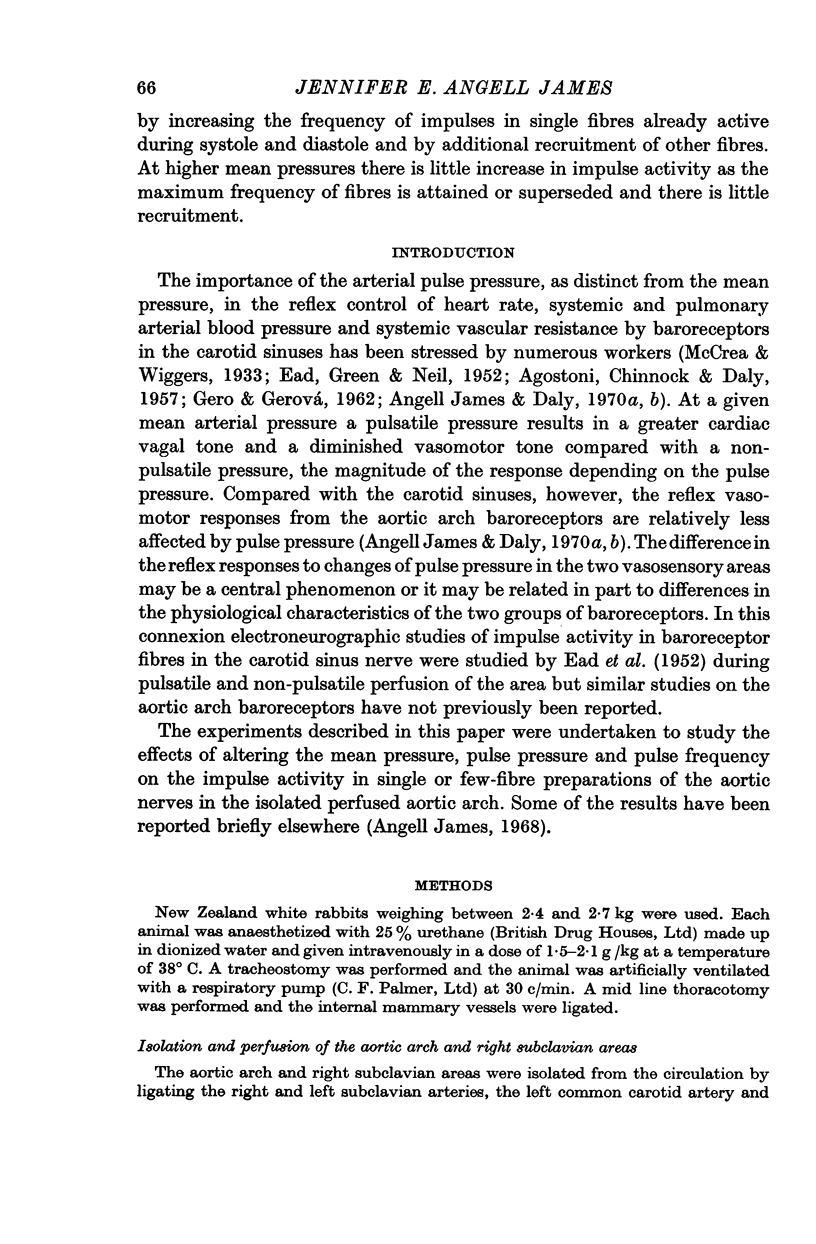
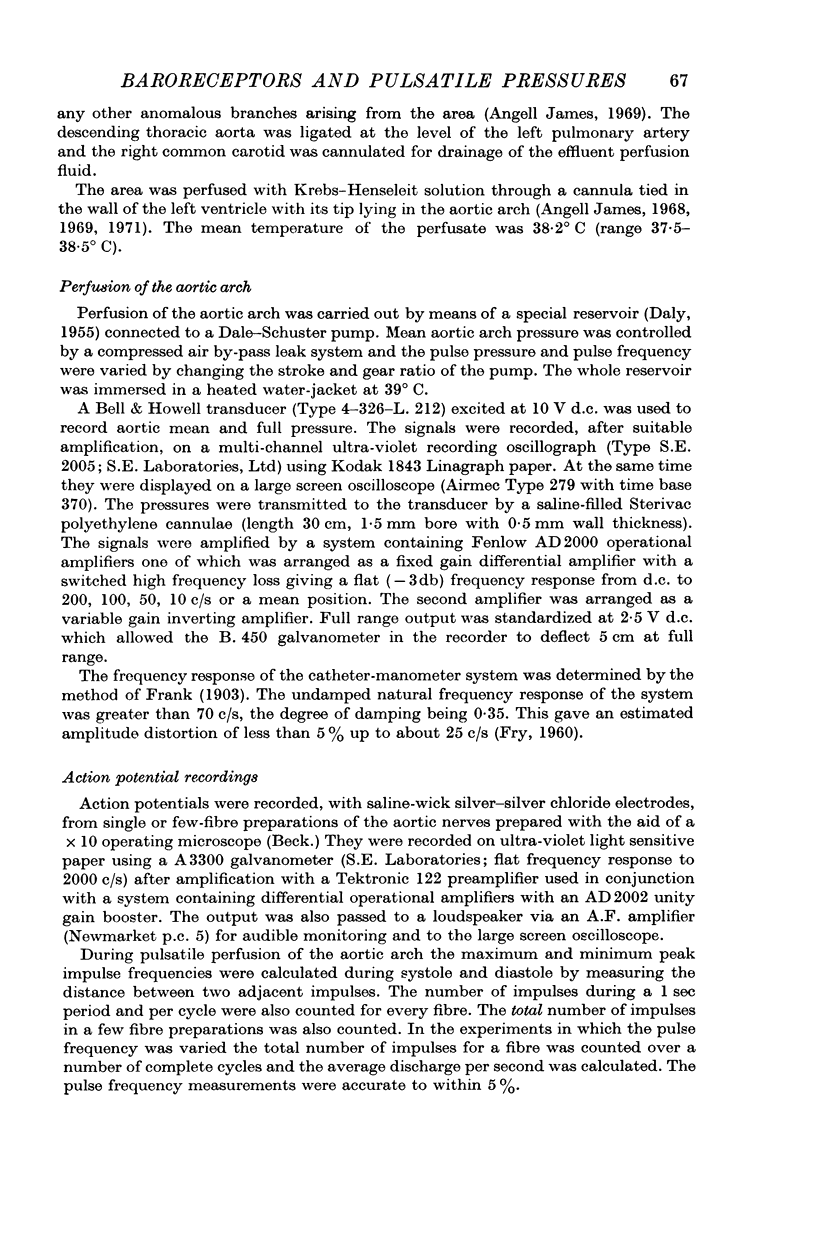
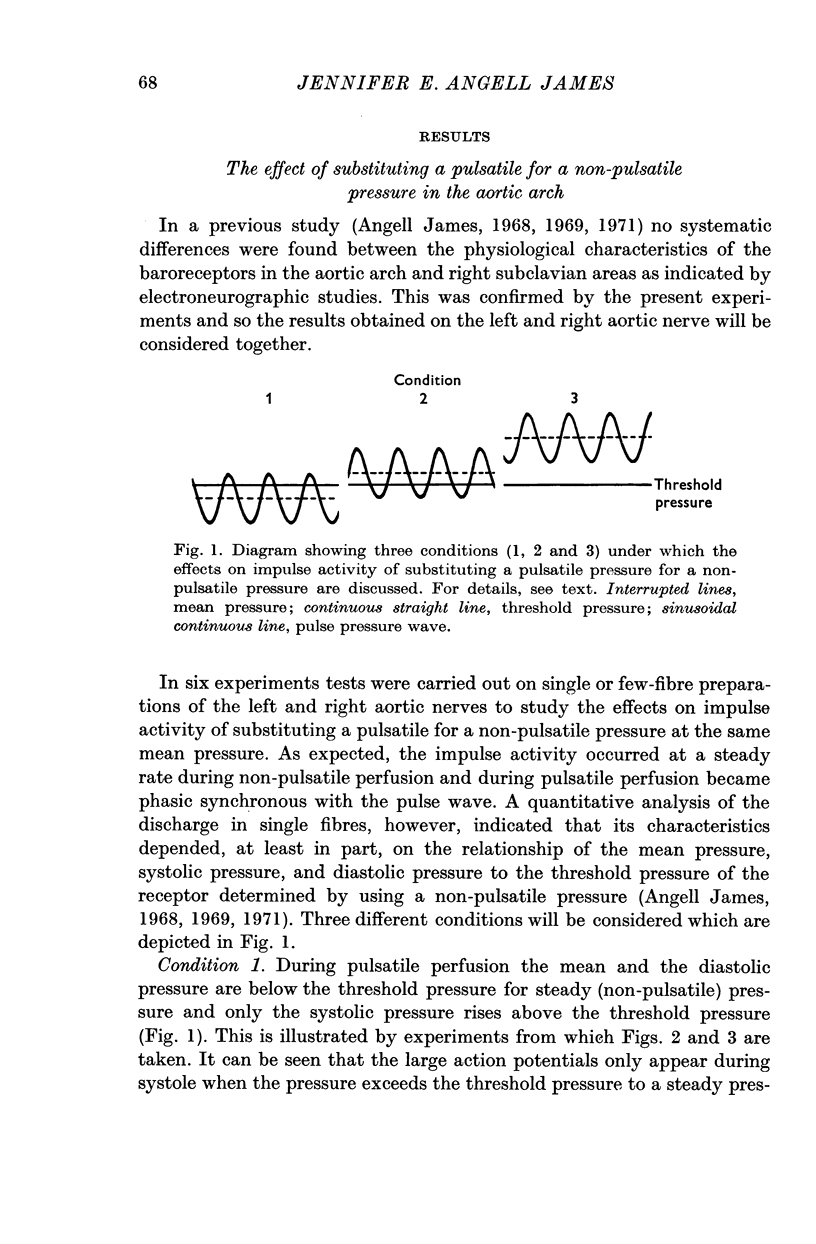
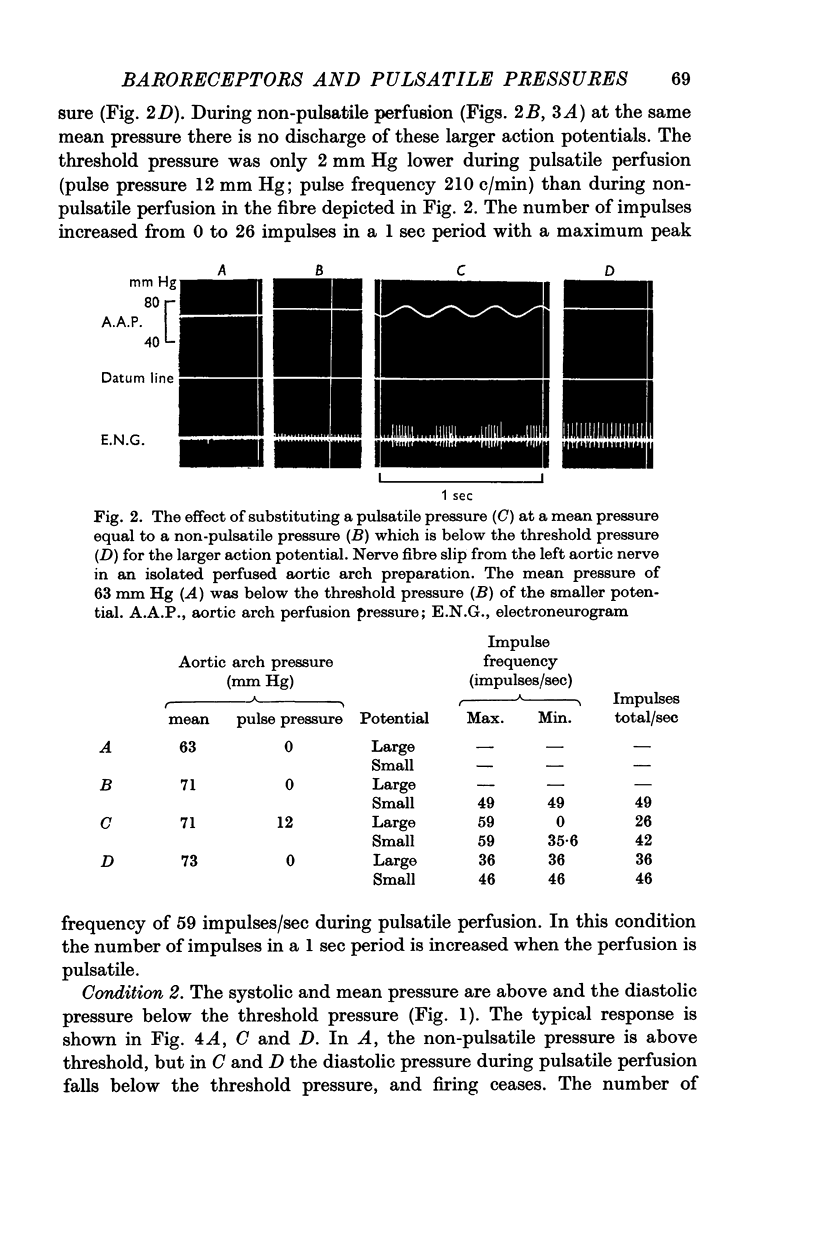
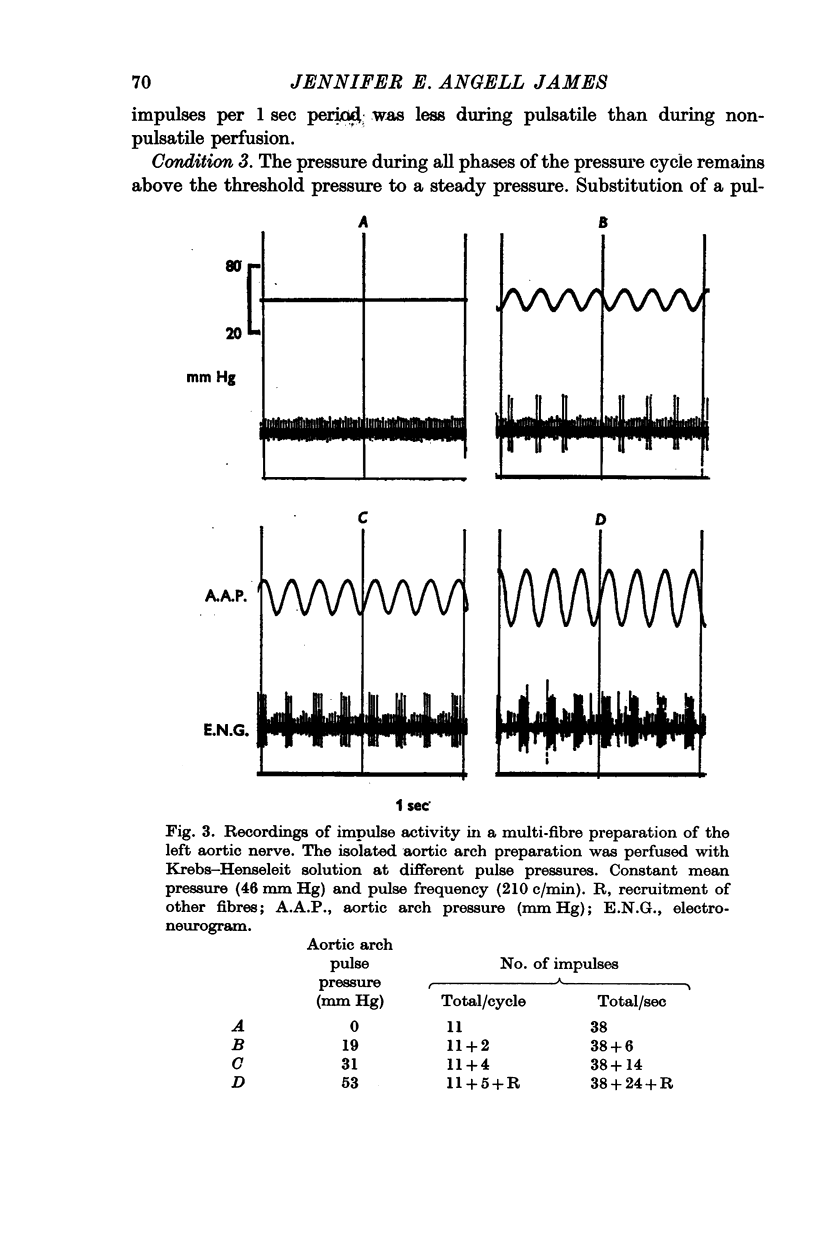
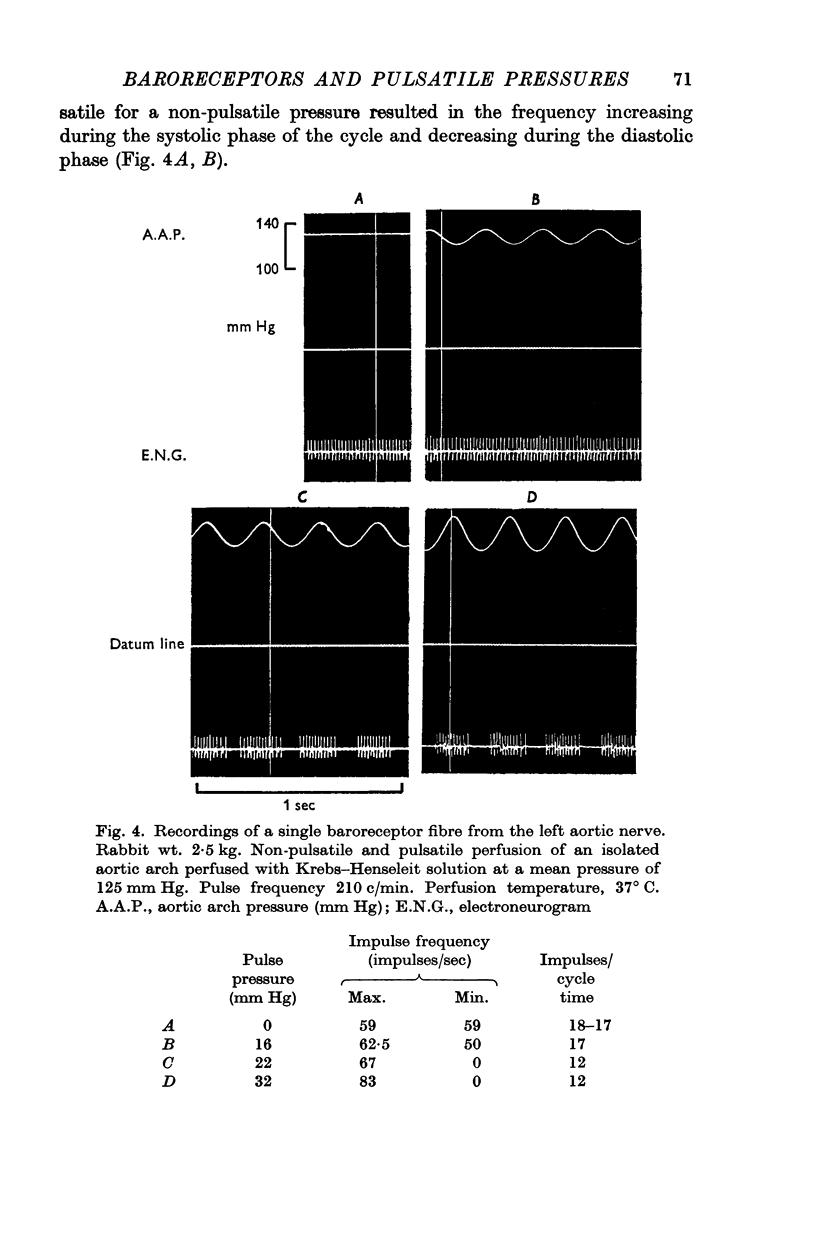
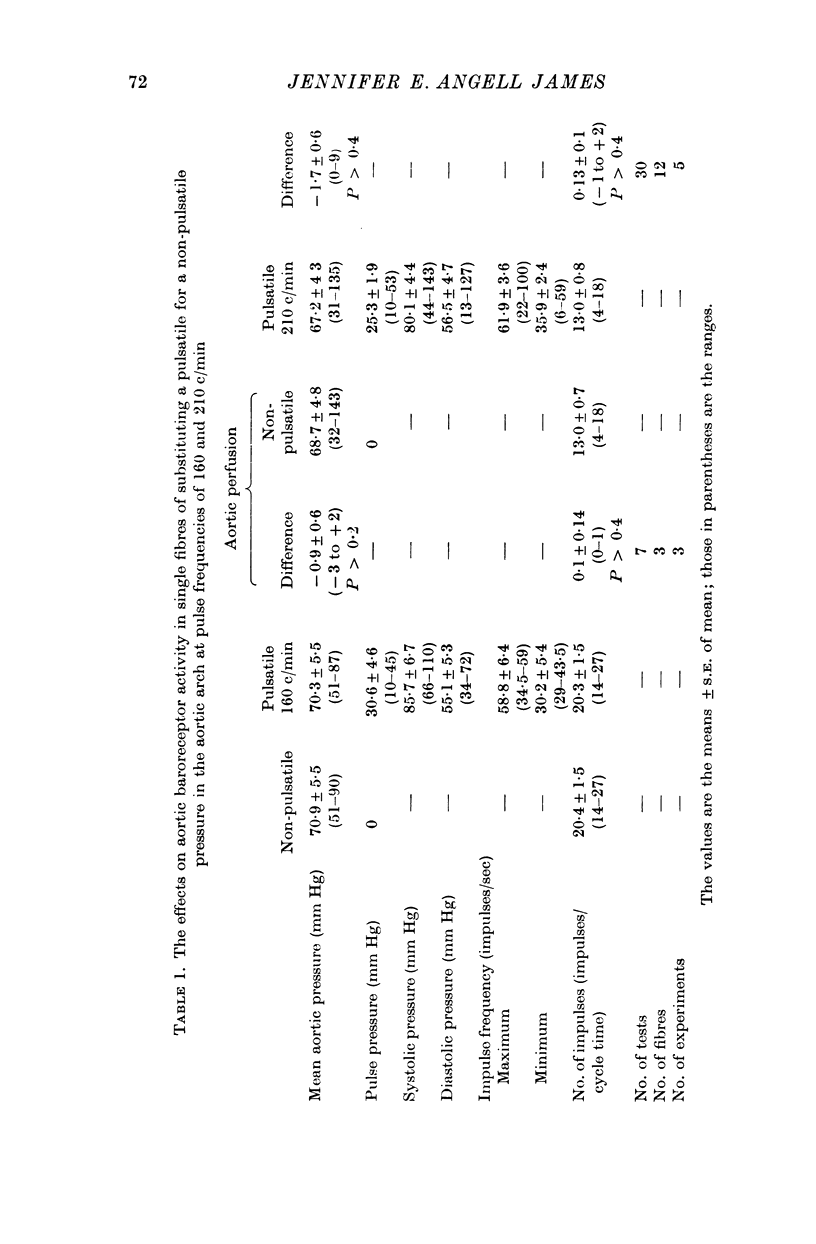
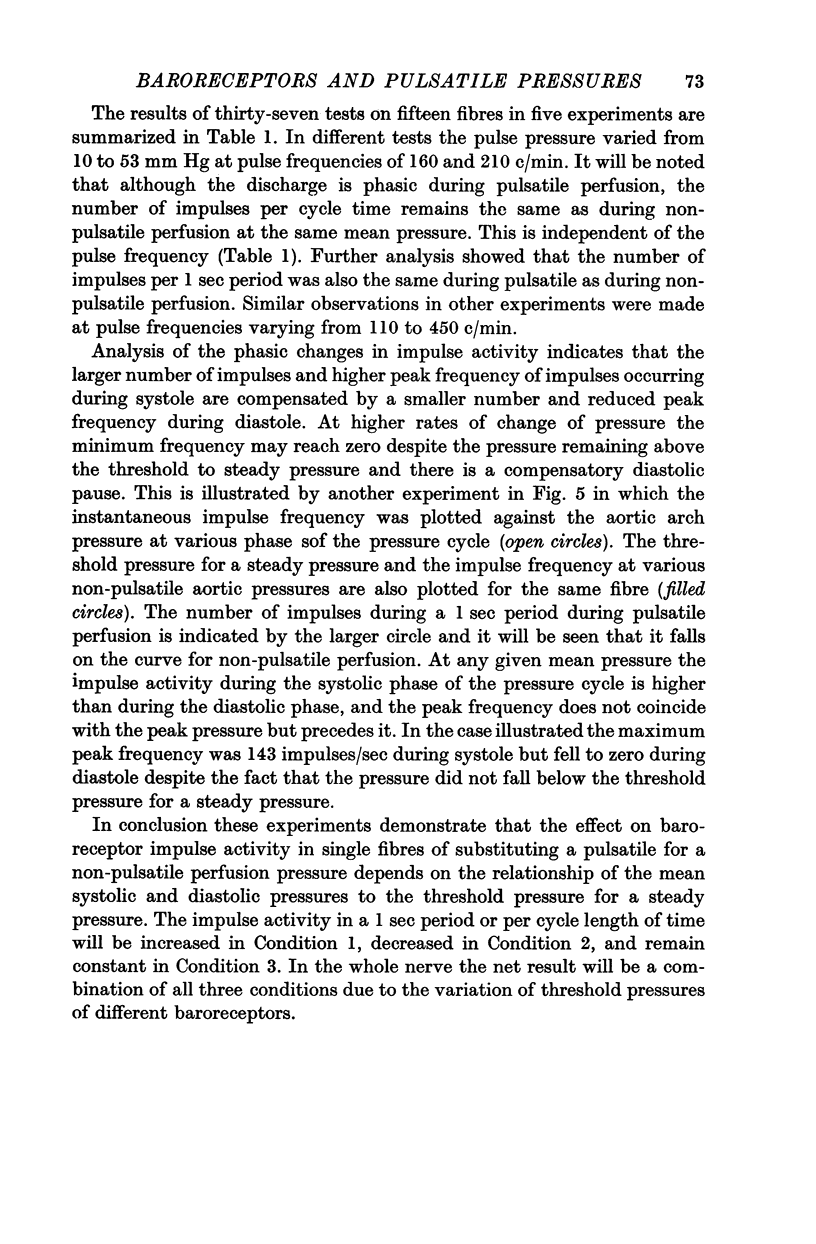
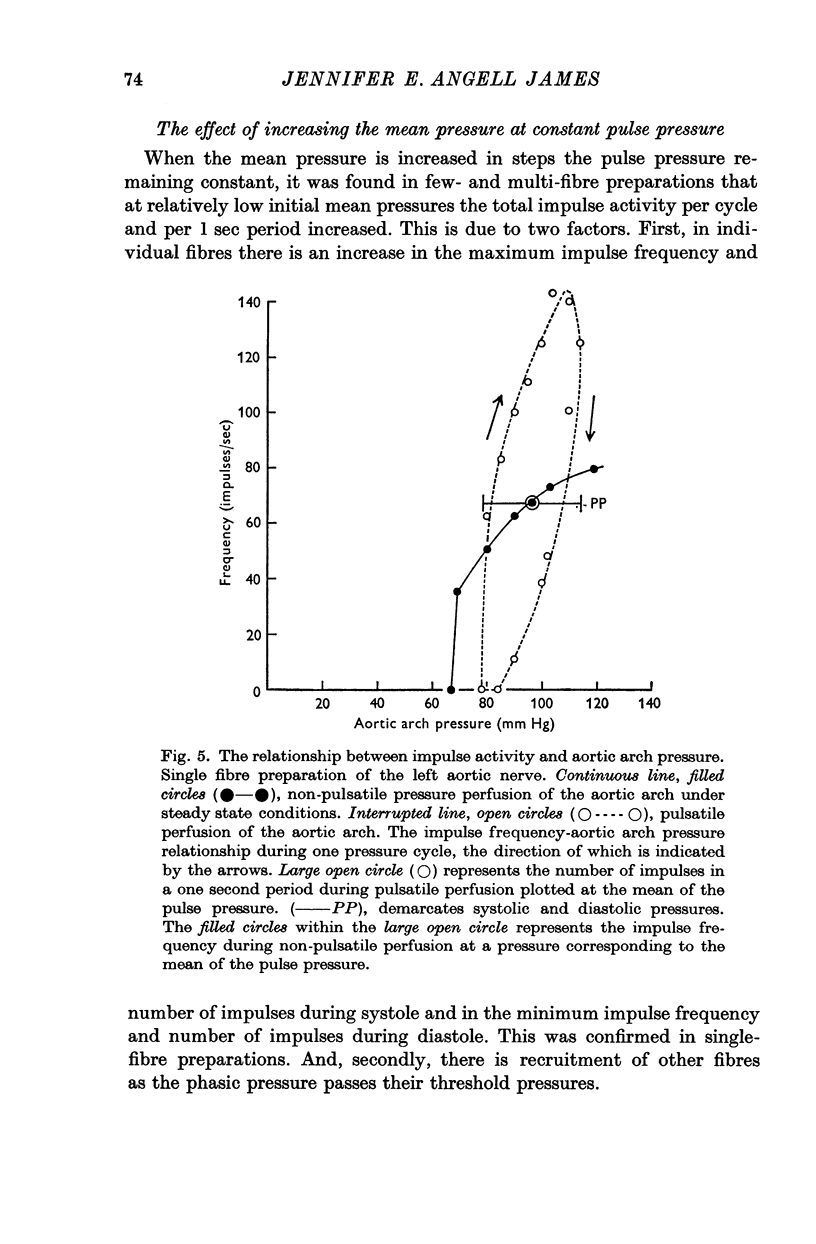
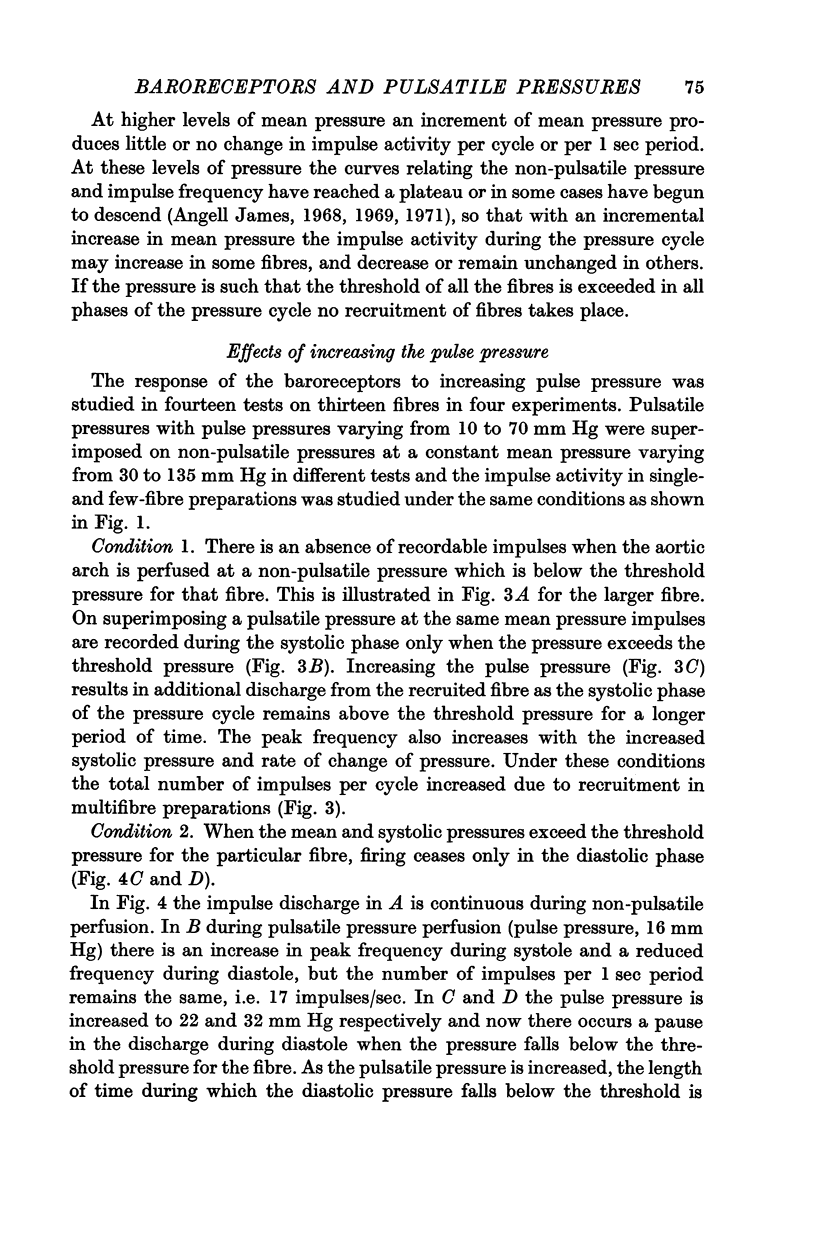
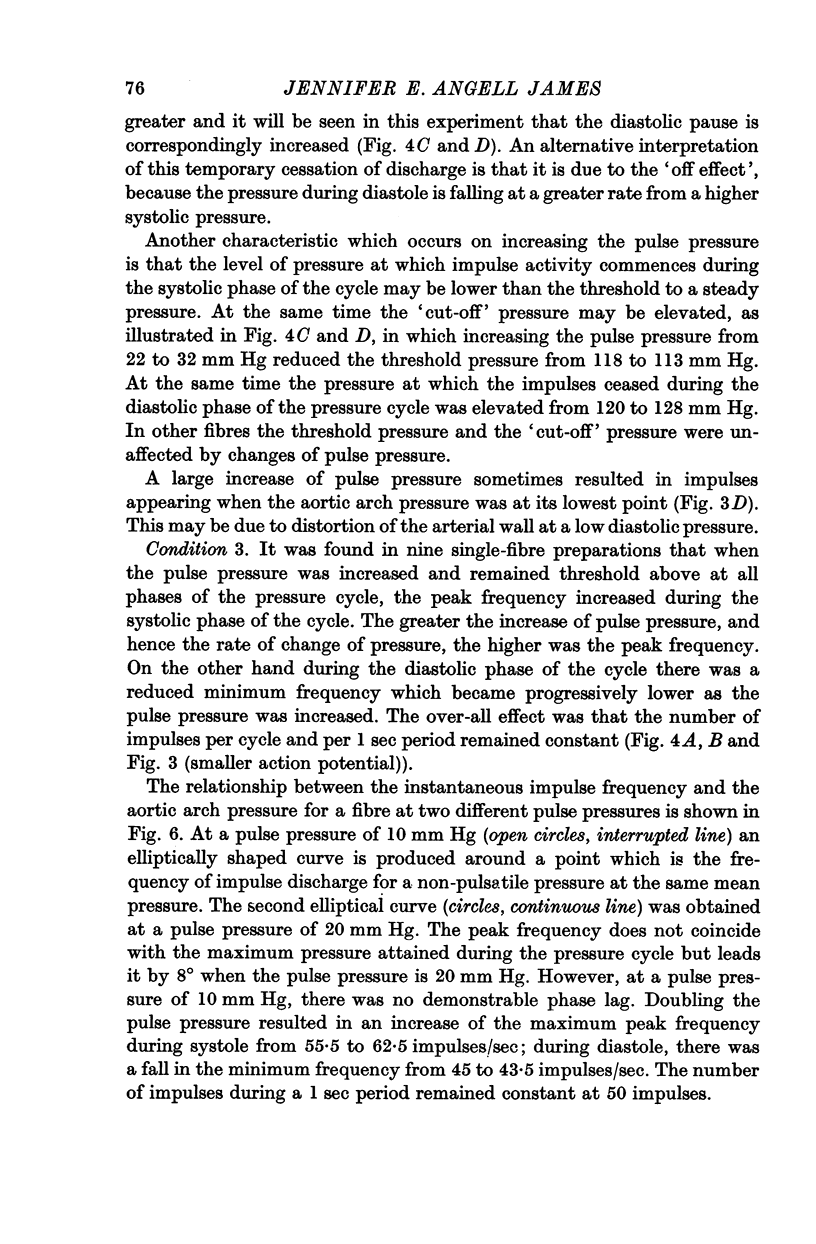
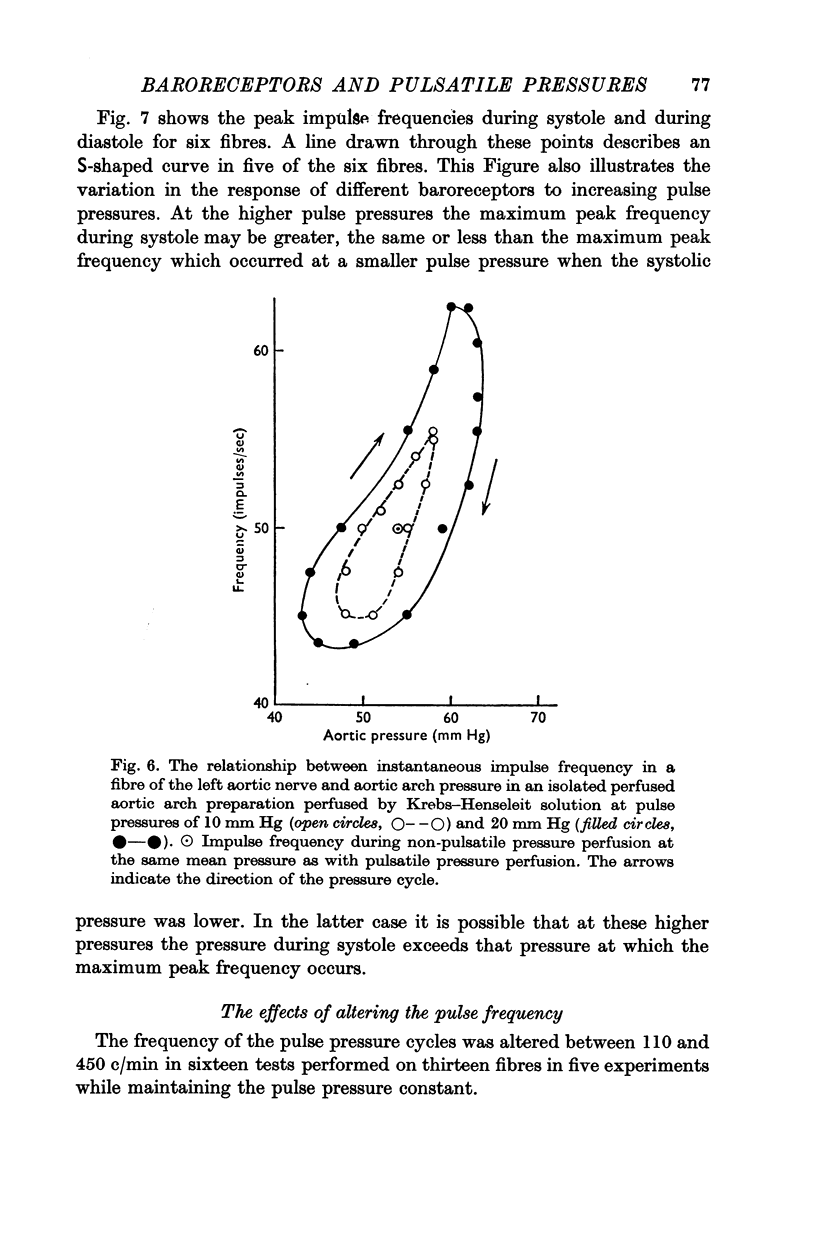
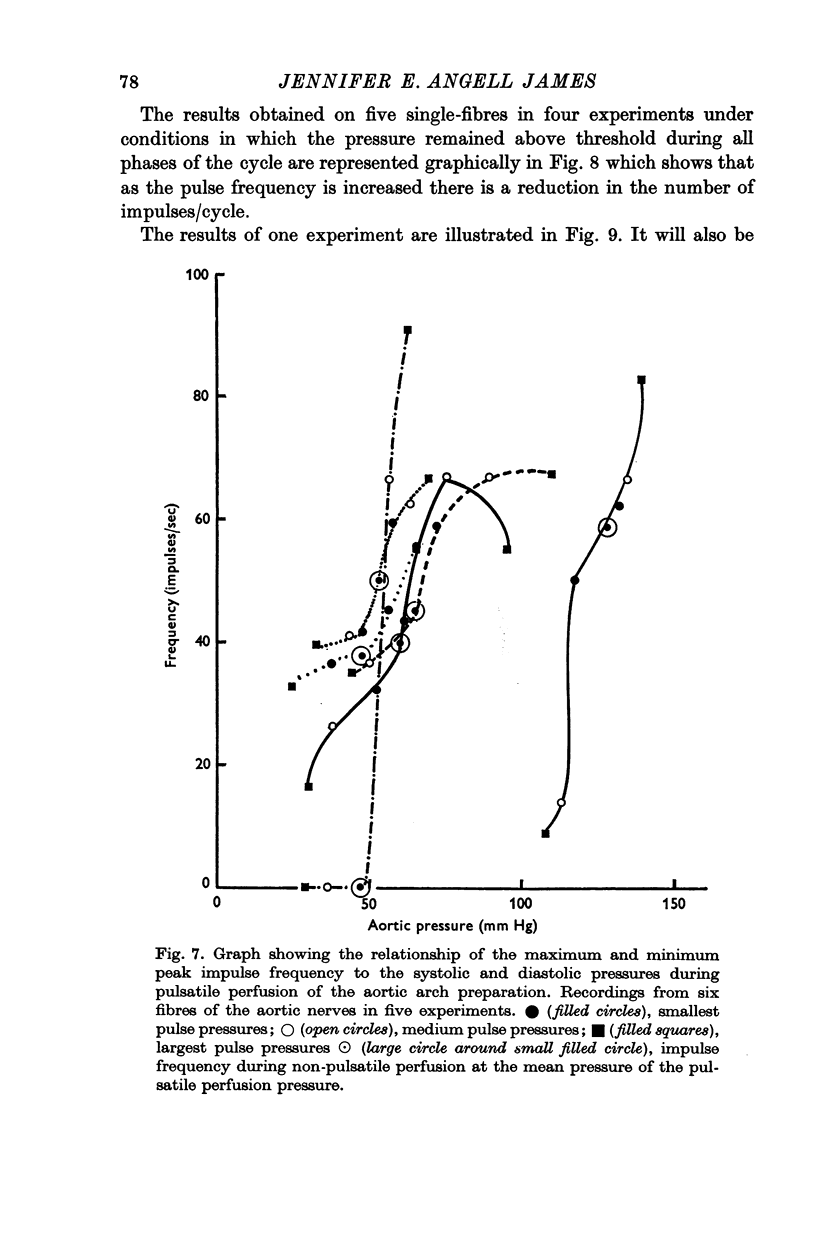
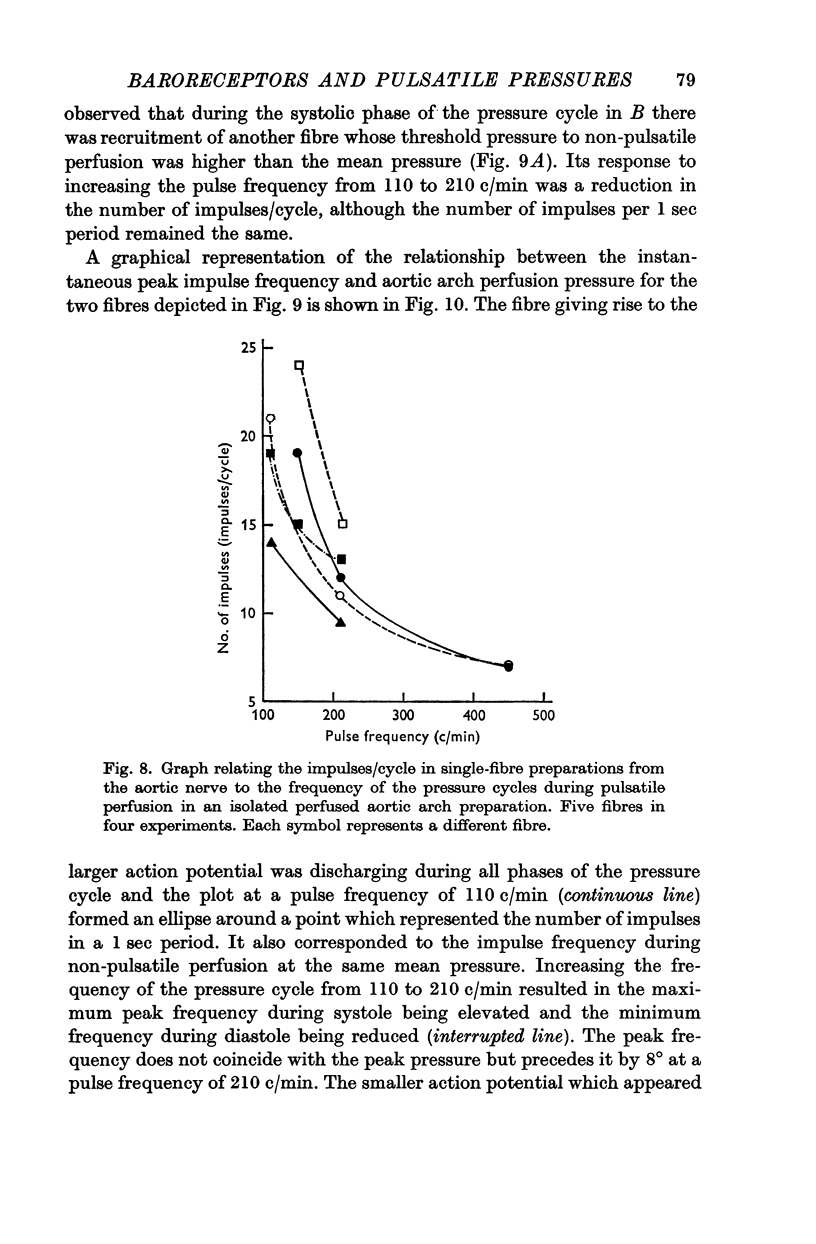
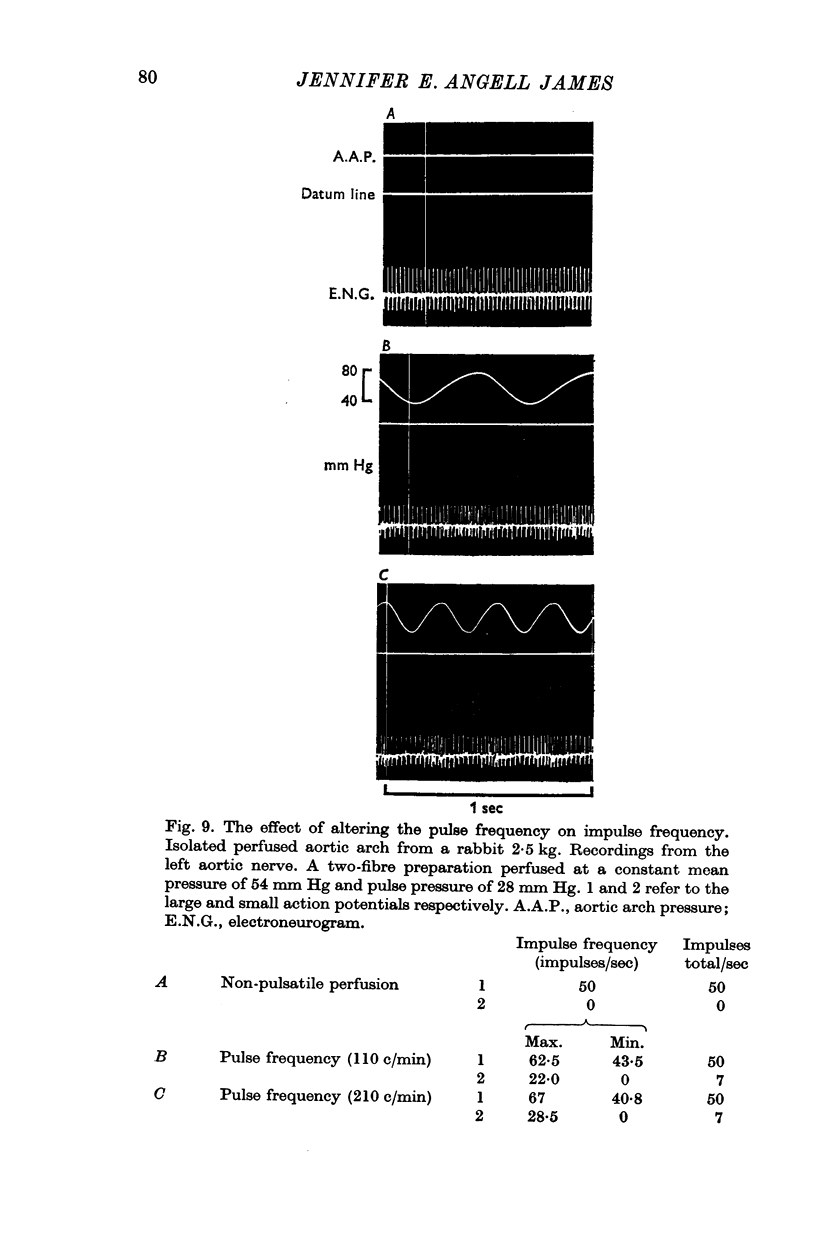
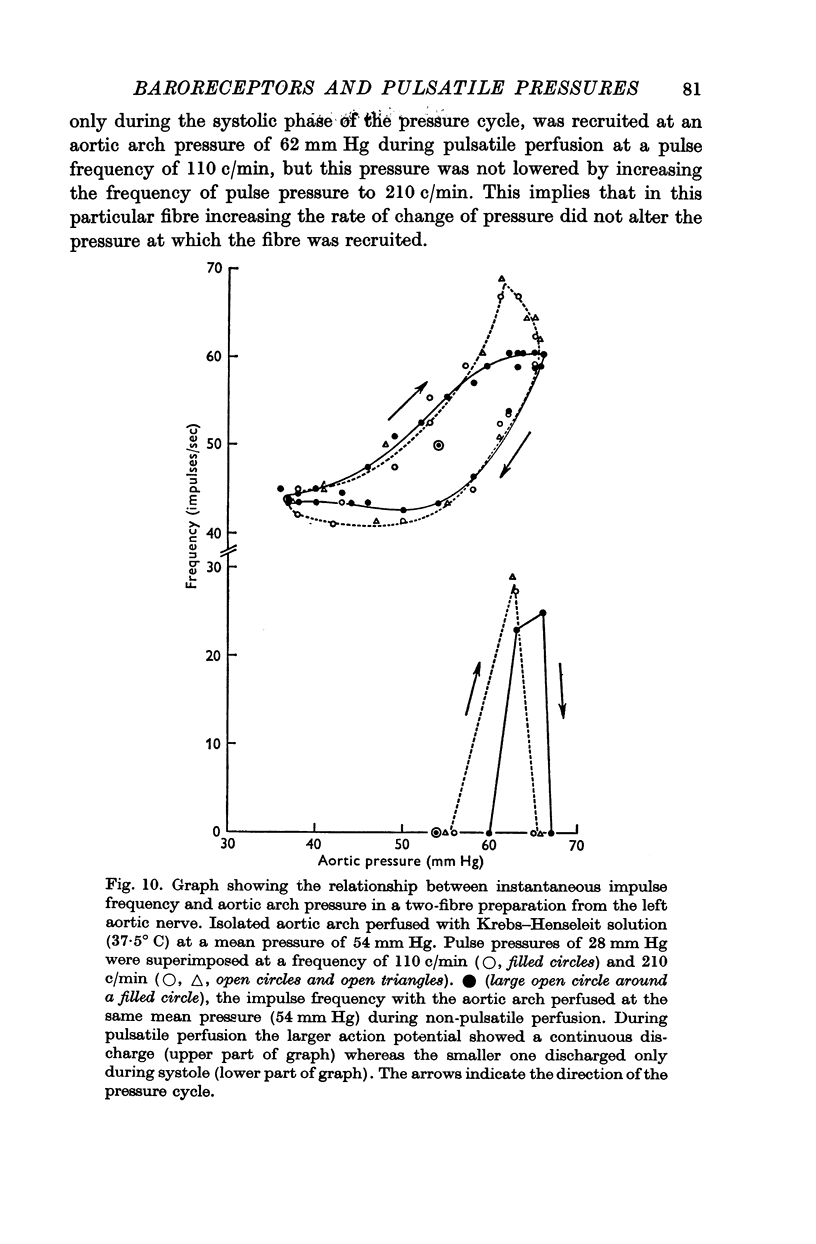
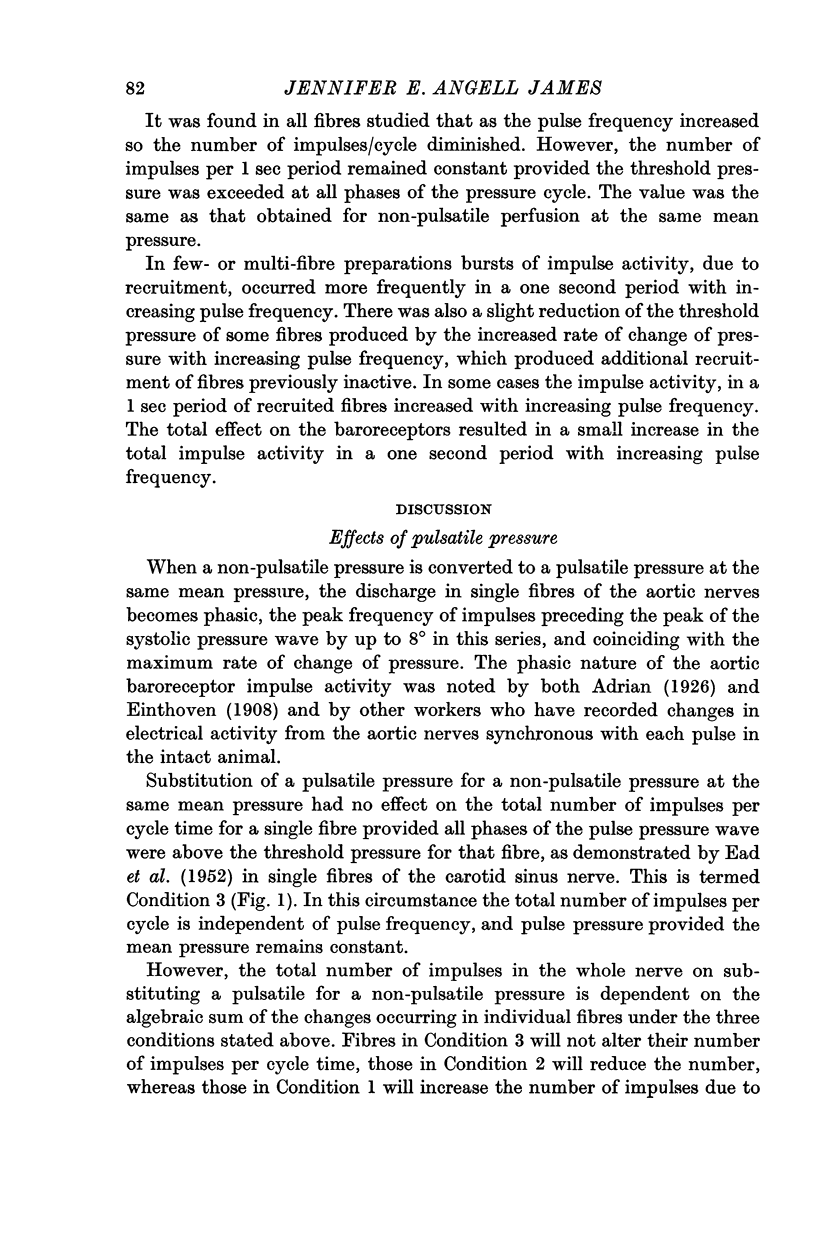
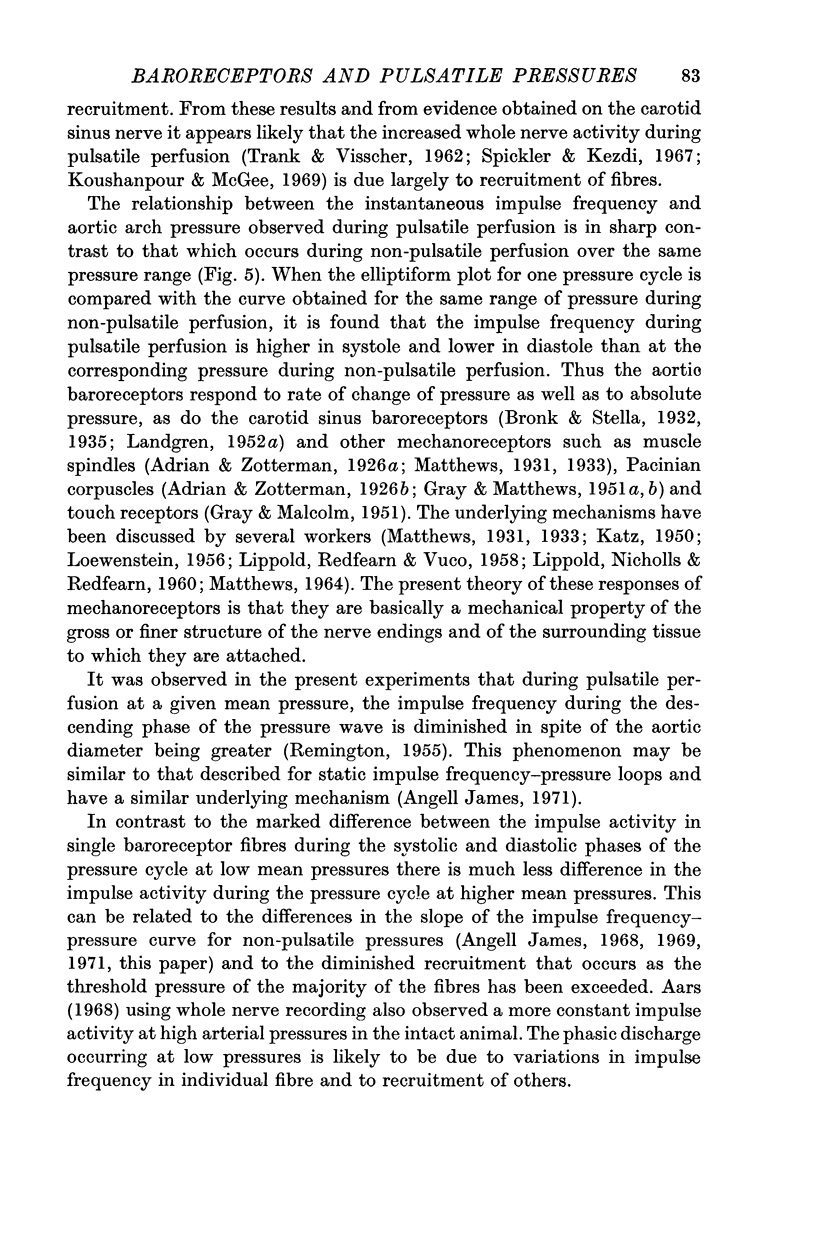
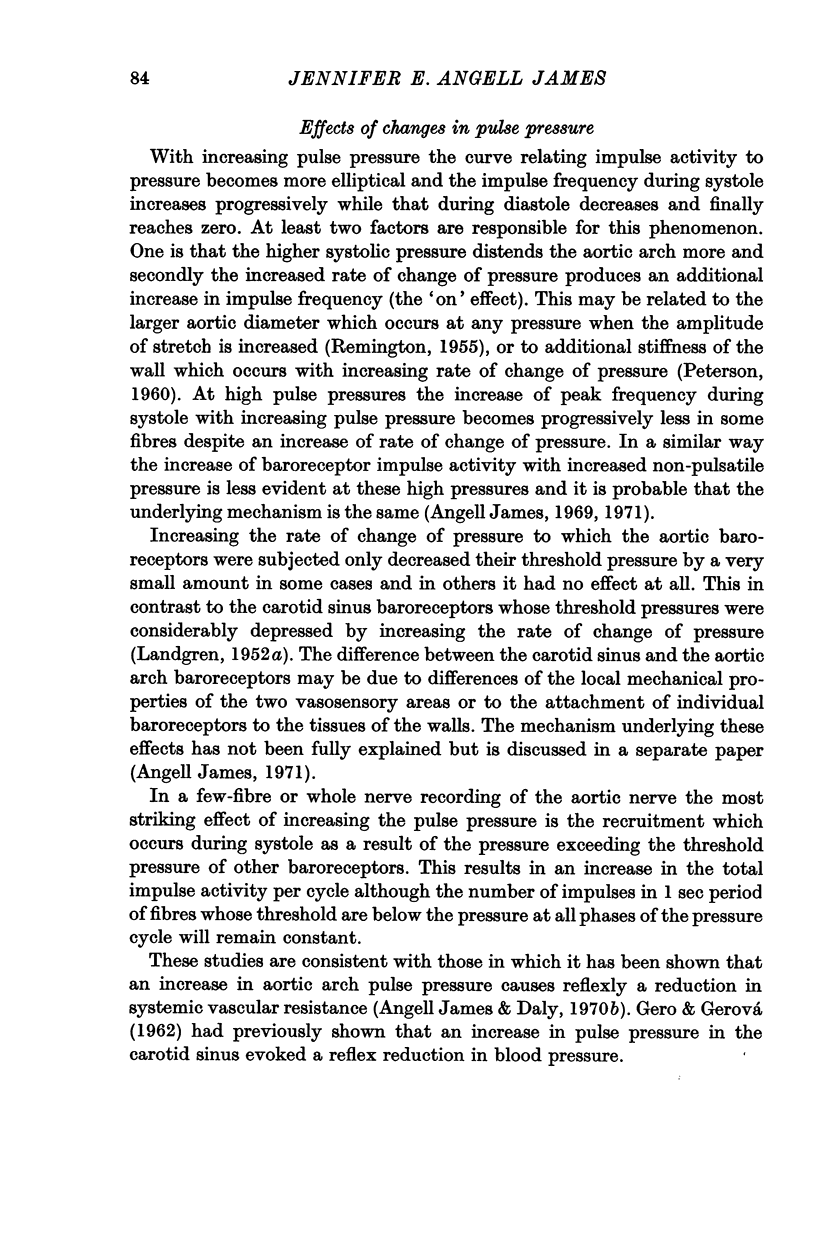
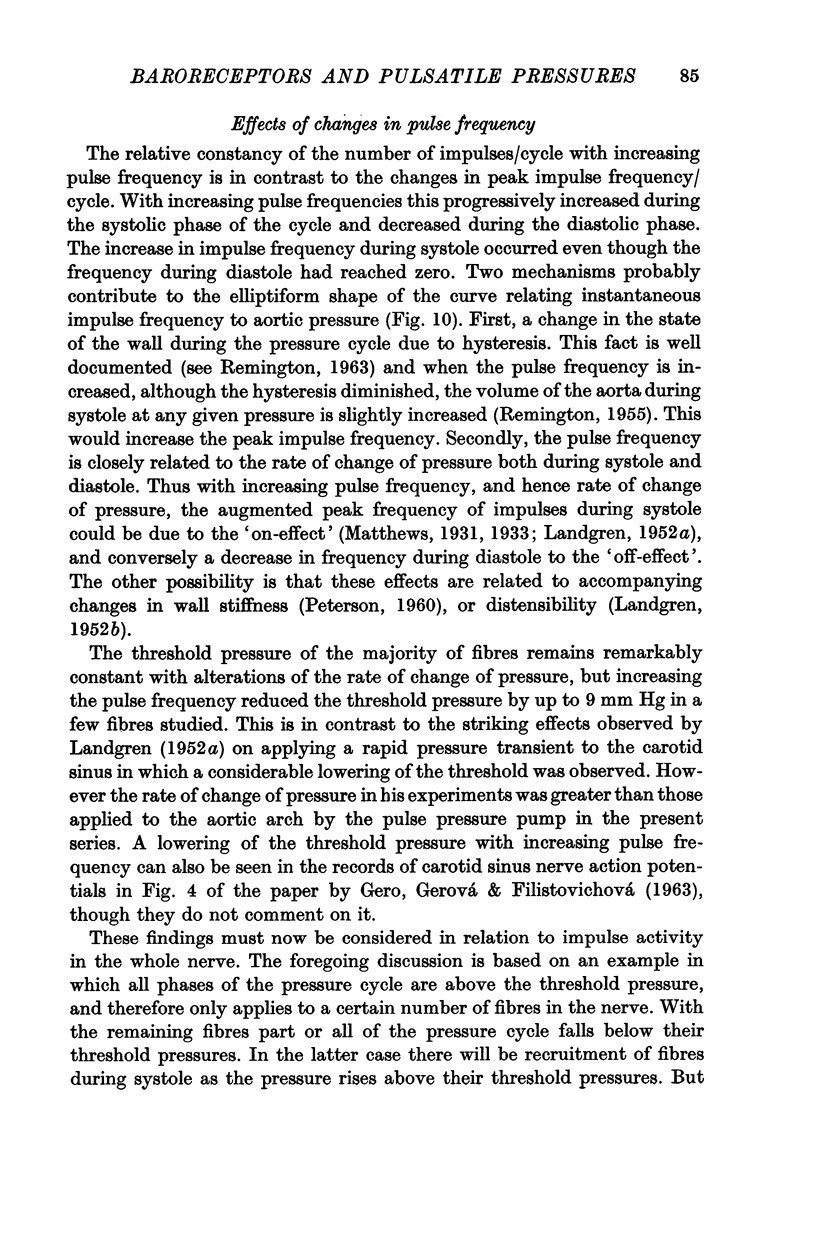
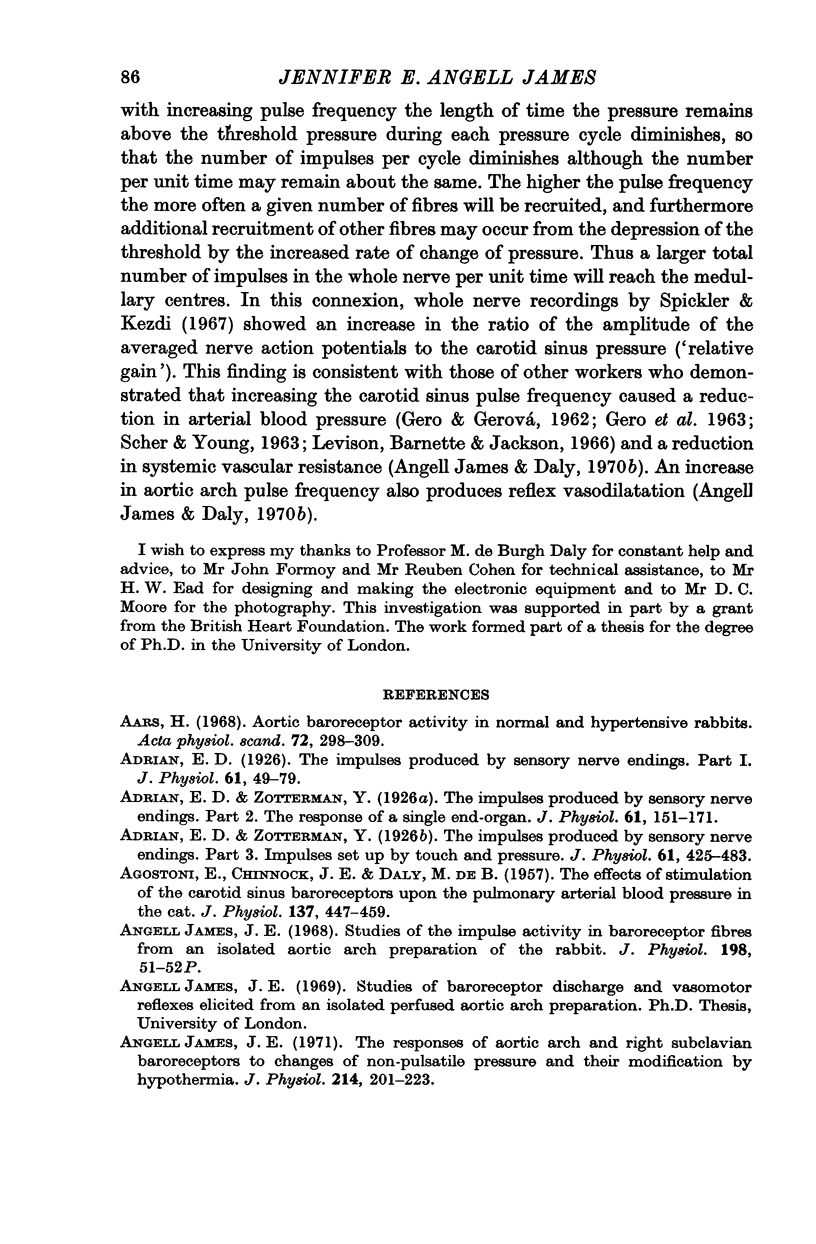
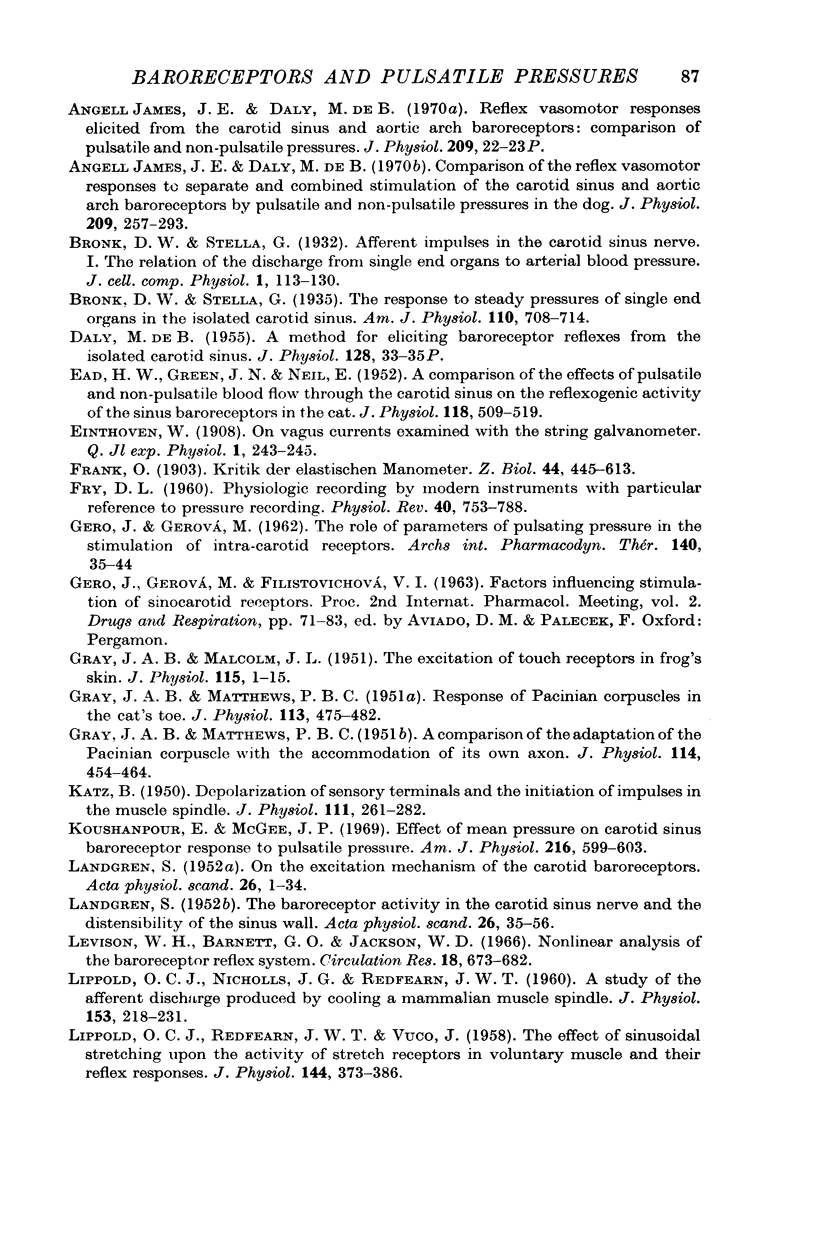
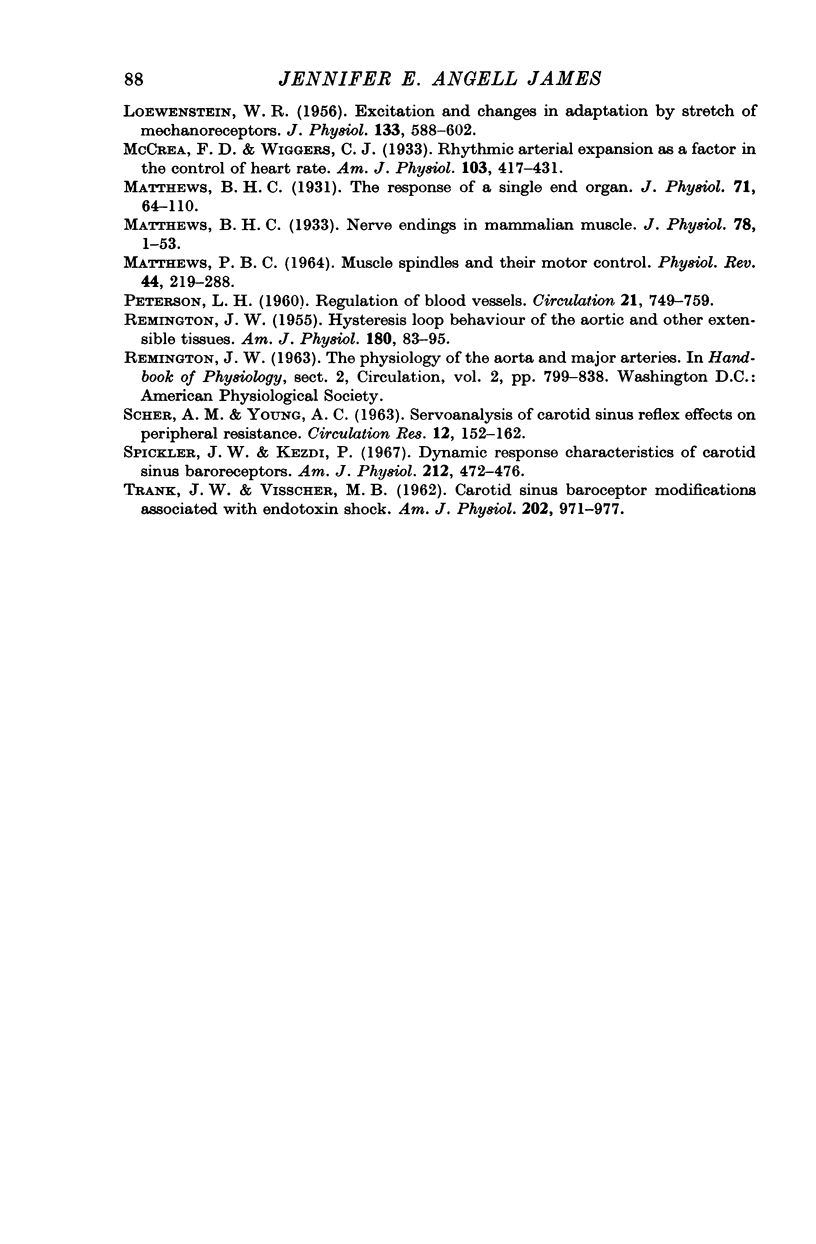
Selected References
These references are in PubMed. This may not be the complete list of references from this article.
- AGOSTONI E., CHINNOCK J. E., DE DALY M B. The effects of stimulation of the carotid sinus baroreceptors upon the pulmonary arterial blood pressure in the cat. J Physiol. 1957 Aug 6;137(3):447–459. doi: 10.1113/jphysiol.1957.sp005826. [DOI] [PMC free article] [PubMed] [Google Scholar]
- Adrian E. D. The impulses produced by sensory nerve endings: Part I. J Physiol. 1926 Mar 18;61(1):49–72. doi: 10.1113/jphysiol.1926.sp002273. [DOI] [PMC free article] [PubMed] [Google Scholar]
- Adrian E. D., Zotterman Y. The impulses produced by sensory nerve endings: Part 3. Impulses set up by Touch and Pressure. J Physiol. 1926 Aug 6;61(4):465–483. doi: 10.1113/jphysiol.1926.sp002308. [DOI] [PMC free article] [PubMed] [Google Scholar]
- Adrian E. D., Zotterman Y. The impulses produced by sensory nerve-endings: Part II. The response of a Single End-Organ. J Physiol. 1926 Apr 23;61(2):151–171. doi: 10.1113/jphysiol.1926.sp002281. [DOI] [PMC free article] [PubMed] [Google Scholar]
- DE BURGH DALY M. A method for eliciting baroreceptor reflexes from the isolated carotid sinus. J Physiol. 1955 May 27;128(2):33–5P. [PubMed] [Google Scholar]
- EAD H. W., GREEN J. H., NEIL E. A comparison of the effects of pulsatile and non-pulsatile blood flow through the carotid sinus on the reflexogenic activity of the sinus baroceptors in the cat. J Physiol. 1952 Dec;118(4):509–519. doi: 10.1113/jphysiol.1952.sp004812. [DOI] [PMC free article] [PubMed] [Google Scholar]
- FRY D. L. Physiologic recording by modern instruments with particular reference to pressure recording. Physiol Rev. 1960 Oct;40:753–788. doi: 10.1152/physrev.1960.40.4.753. [DOI] [PubMed] [Google Scholar]
- GERO J., GEROVA M. The role of parameters of pulsating pressure in the stimulation of intracarotid receptors. Arch Int Pharmacodyn Ther. 1962 Nov 1;140:35–44. [PubMed] [Google Scholar]
- GRAY J. A. B., MALCOLM J. L. The excitation of touch receptors in frog's skin. J Physiol. 1951 Sep;115(1):1–15. doi: 10.1113/jphysiol.1951.sp004648. [DOI] [PMC free article] [PubMed] [Google Scholar]
- GRAY J. A. B., MATTHEWS P. B. C. A comparison of the adaptation of the Pacinian corpuscle with the accommodation of its own axon. J Physiol. 1951 Aug;114(4):454–464. doi: 10.1113/jphysiol.1951.sp004636. [DOI] [PMC free article] [PubMed] [Google Scholar]
- GRAY J. A. B., MATTHEWS P. B. C. Response of Pacinian corpuscles in the cat's toe. J Physiol. 1951 May;113(4):475–482. doi: 10.1113/jphysiol.1951.sp004589. [DOI] [PMC free article] [PubMed] [Google Scholar]
- James J. E., Daly M. de B. Comparison of the reflex vasomotor responses to separate and combined stimulation of the carotid sinus and aortic arch baroreceptors by pulsatile and non-pulsatile pressures in the dog. J Physiol. 1970 Aug;209(2):257–293. doi: 10.1113/jphysiol.1970.sp009165. [DOI] [PMC free article] [PubMed] [Google Scholar]
- James J. E. The responses of aortic arch and right subclavian baroreceptors to changes of non-pulsatile pressure and their modification by hypothermia. J Physiol. 1971 Apr;214(2):201–223. doi: 10.1113/jphysiol.1971.sp009428. [DOI] [PMC free article] [PubMed] [Google Scholar]
- KATZ B. Depolarization of sensory terminals and the initiation of impulses in the muscle spindle. J Physiol. 1950 Oct 16;111(3-4):261–282. doi: 10.1113/jphysiol.1950.sp004479. [DOI] [PMC free article] [PubMed] [Google Scholar]
- Koushanpour E., McGee J. P. Effect of mean pressure on carotid sinus baroceptor response to pulsatile pressure. Am J Physiol. 1969 Mar;216(3):599–603. doi: 10.1152/ajplegacy.1969.216.3.599. [DOI] [PubMed] [Google Scholar]
- LANDGREN S. On the excitation mechanism of the carotid baroceptors. Acta Physiol Scand. 1952 Jul 17;26(1):1–34. doi: 10.1111/j.1748-1716.1952.tb00889.x. [DOI] [PubMed] [Google Scholar]
- LANDGREN S. The baroceptor activity in the carotid sinus nerve and the distensibility of the sinus wall. Acta Physiol Scand. 1952 Jul 17;26(1):35–56. doi: 10.1111/j.1748-1716.1952.tb00890.x. [DOI] [PubMed] [Google Scholar]
- LIPPOLD O. C., NICHOLLS J. G., REDFEARN J. W. A study of the afferent discharge produced by cooling a mammalian muscle spindle. J Physiol. 1960 Sep;153:218–231. doi: 10.1113/jphysiol.1960.sp006530. [DOI] [PMC free article] [PubMed] [Google Scholar]
- LIPPOLD O. C., REDFEARN J. W., VUCO J. The effect of sinusoidal stretching upon the activity of stretch receptors in voluntary muscle and their reflex responses. J Physiol. 1958 Dec 30;144(3):373–386. doi: 10.1113/jphysiol.1958.sp006108. [DOI] [PMC free article] [PubMed] [Google Scholar]
- LOEWENSTEIN W. R. Excitation and changes in adaptation by stretch of mechanoreceptors. J Physiol. 1956 Sep 27;133(3):588–602. doi: 10.1113/jphysiol.1956.sp005611. [DOI] [PMC free article] [PubMed] [Google Scholar]
- Levison W. H., Barnett G. O., Jackson W. D. Nonlinear analysis of the baroreceptor reflex system. Circ Res. 1966 Jun;18(6):673–682. doi: 10.1161/01.res.18.6.673. [DOI] [PubMed] [Google Scholar]
- MATTHEWS P. B. MUSCLE SPINDLES AND THEIR MOTOR CONTROL. Physiol Rev. 1964 Apr;44:219–288. doi: 10.1152/physrev.1964.44.2.219. [DOI] [PubMed] [Google Scholar]
- Matthews B. H. Nerve endings in mammalian muscle. J Physiol. 1933 Apr 13;78(1):1–53. doi: 10.1113/jphysiol.1933.sp002984. [DOI] [PMC free article] [PubMed] [Google Scholar]
- Matthews B. H. The response of a single end organ. J Physiol. 1931 Jan 21;71(1):64–110. doi: 10.1113/jphysiol.1931.sp002718. [DOI] [PMC free article] [PubMed] [Google Scholar]
- PETERSON L. H. Regulation of blood vessels. Circulation. 1960 May;21:749–759. doi: 10.1161/01.cir.21.5.749. [DOI] [PubMed] [Google Scholar]
- REMINGTON J. W. Hysteresis loop behavior of the aorta and other extensible tissues. Am J Physiol. 1955 Jan;180(1):83–95. doi: 10.1152/ajplegacy.1954.180.1.83. [DOI] [PubMed] [Google Scholar]
- SCHER A. M., YOUNG A. C. Servoanalysis of carotid sinus reflex effects on peripheral resistance. Circ Res. 1963 Feb;12:152–162. doi: 10.1161/01.res.12.2.152. [DOI] [PubMed] [Google Scholar]
- Spickler J. W., Kezdi P. Dynamic response characteristics of carotid sinus baroreceptors. Am J Physiol. 1967 Feb;212(2):472–476. doi: 10.1152/ajplegacy.1967.212.2.472. [DOI] [PubMed] [Google Scholar]
- TRANK J. W., VISSCHER M. B. Carotid sinus baroceptor modifications associated with endotoxin shock. Am J Physiol. 1962 May;202:971–977. doi: 10.1152/ajplegacy.1962.202.5.971. [DOI] [PubMed] [Google Scholar]


